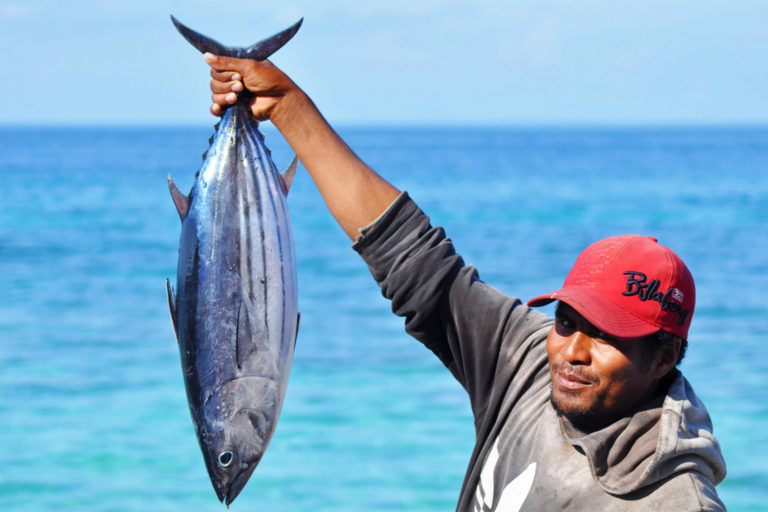- Indonesia has invited Turkish investors to participate in offshore tuna farming in the Papua region’s Biak Numfor district, aiming to make it a hub for tuna exports.
- The Indonesian fisheries ministry said Turkish fisheries operators can bring innovation to enhance productivity and ensure sustainability of the tuna fishery.
- Indonesia, a significant contributor to global tuna production, faces sustainability challenges due to excessive harvesting of wild tuna.
- The outreach to Türkiye is the latest in efforts to get foreign investors to help develop Indonesia’s various fisheries, including a similar offer earlier in January for Vietnam to invest in lobster farms.
JAKARTA — The Indonesian government has invited Turkish investors to help develop an offshore tuna farm in the country’s eastern Papua region, which it aims to turn into a major tuna export hub.
The move is the latest outreach by Indonesia’s fisheries ministry to other countries to invest in and develop its fisheries potential. Earlier in January, the minister made a similar offer to Vietnam to invest in lobster farming.
On a recent visit to Türkiye, the Indonesian fisheries minister, Sakti Wahyu Trenggono, said Turkish investment and aquaculture technology could help kick-start tuna farming in the waters of Biak Numfor district in Papua province. The minister spoke at a fish-fattening farm in the Türkiye’s Gulf of İzmir, where various marine fish species, including Atlantic bluefin tuna (Thunnus thynnus), are held in pens after being captured from the wild and fed to increase their weight.
“Some of our territorial waters are habitat for tuna, so we need innovation to increase the productivity of this commodity and ensure its sustainability,” Trenggono said in a statement published Jan. 24.

At the start of his second term in office, in 2019, President Joko Widodo ordered the fisheries ministry to boost the country’s aquaculture productivity. Indonesia’s tuna fishery is an important source of livelihood for coastal communities in the Southeast Asian nation and a key source of food for consumers around the world, contributing about 16% to the total global tuna production.
However, the excessive harvesting of wild tuna in Indonesian waters has rendered the fishery unsustainable. A substantial portion of the country’s fishing areas in the Pacific and Indian oceans has been fully utilized, leading to overfishing of numerous tuna species.
Trenggono said Turkish investors were specifically interested in Biak Numfor, located within the biodiverse Cenderawasih Bay and part of the Pacific Coral Triangle, the leading hotspot for marine biodiversity.
“This is the most suitable area because it borders the northern Pacific waters, so the most suitable location is Biak [and] Kupang which is very close to the Indian [Ocean] waters,” Trenggono told Mongabay on the sidelines of an event in Jakarta.
The Papuan district last November opened its first so-called modern fishing village with key infrastructure for tuna fisheries, such as ice factories, cold storage, catch-landing shelters and docking yards, all built by the central government. Other supporting facilities include a training center, clean water installation, drainage, street lighting, waste water management installation, and management office.
The tuna fishery in Biak Numfor is a rich source of yellowfin tuna (Thunnus albacares), with officials estimating it could produce up to 1 million metric tons annually. There are also plans to expand direct export by air from Papua to Japan, one of Indonesia’s top tuna buyers. Currently, there’s only one flight a week flying that route. There were 29 freight shipments between January and August 2023, with a total of 140.4 metric tons of tuna sent to Japan from Biak Numfor, according to the district fisheries agency.
Indonesia’s waters are also home to several other species of commercially valuable tuna, including longfin or albacore (T. alalunga), bigeye (T. obesus) and southern bluefin (T. maccoyii).

In 2021, Indonesia caught 791,000 metric tons of tuna, with a total value of about $1.4 billion. About a fifth of this catch was exported, primarily to United States, Japan, Thailand, Saudi Arabia, the European Union, Australia, Vietnam, the United Kingdom, and the Philippines.
The growth of Indonesia’s fisheries is part of a global trend in aquaculture, which expanded by 527% between 1990 and 2018, with Indonesia one of the top contributors. In the third quarter of 2021, Indonesia’s aquaculture output reached 12.25 million metric tons, reflecting a 6% rise from the same period in 2020. The aquaculture sector has also grown in economic importance, generating revenue in excess of government targets, according to the fisheries ministry.
The ministry has implemented various initiatives to maintain sustainable levels of tuna production. These include implementing harvest controls, monitoring specific species in selected fisheries areas, regulating the use of fish-aggregating devices, and pushing for international-standard sustainability certification among fishers. Developing tuna farms is the latest in efforts to ease the pressure on wild stocks.
The government is also pushing for more tuna fisheries in Indonesia to achieve sustainability certification and eco-labeling. Numerous programs are available to ensure the certification of sustainable fish stocks, minimize environmental impacts, uphold labor rights, establish transparency and traceability in the supply chain, and govern management according to best practices.

Basten Gokkon is a senior staff writer for Indonesia at Mongabay. Find him on 𝕏 @bgokkon.
See related from this reporter:
Indonesia to cut tuna harvest in bid for more sustainable fishery
FEEDBACK: Use this form to send a message to the author of this post. If you want to post a public comment, you can do that at the bottom of the page.